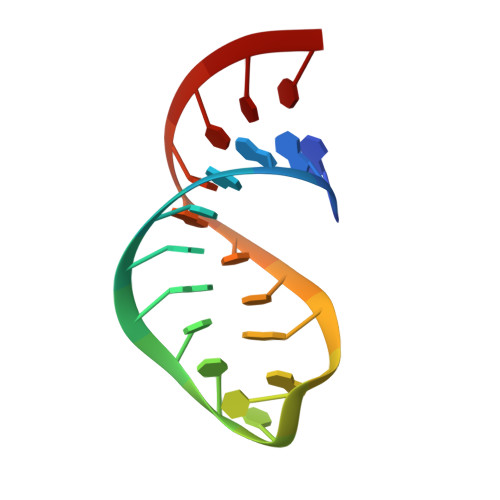Structure of the P1 helix from group I self-splicing introns.
Allain, F.H., Varani, G.(1995) J Mol Biol 250: 333-353
- PubMed: 7608979
- DOI: https://doi.org/10.1006/jmbi.1995.0381
- Primary Citation of Related Structures:
1HLX - PubMed Abstract:
The upstream cleavage site of group I self-splicing introns is identified by an absolutely conserved U.G base-pair within a double helix. Mutant introns with a wobble C.A substitute are catalytically active, but all other combinations of nucleotides at these positions abolish splicing, suggesting that an unusual RNA structure generated by the wobble pair is recognized by the catalytic intron core. The solution structure of a 20-mer oligonucleotide containing a UUCG tetraloop hairpin and a U.G wobble pair within a double helix was determined by NMR spectroscopy without any assumptions on RNA conformation. Isotopically (15N/13C)-labelled RNA was used to collect an unusually large number of experimental constraints (703 in total, corresponding to approximately 35 constraints per nucleotide) leading to the determination of a structure with very high precision (overall root-mean-square-deviation (rmsd) between 20 converged structures 1.22 A, local rmsd 0.6 A for the tetraloop and 0.85 A for the stem). Analysis of the double helical structure at the conserved U.G wobble pair reveals local distortions from the regular A-form pattern, that may constitute the characteristic feature of U.G wobble pair recognized by the group I intron core and by amino acyl tRNA synthetases. Re-examination of the previously determined tetraloop structure reveals a novel U.G base-pair with a syn guanosine and hydrogen bonding contacts involving both base protons and a sugar 2'-OH. This explains the great stability of RNA UUCG loops when compared with DNA loops of identical sequence, and is one of the first NMR observations of RNA 2'-OH resonances.
Organizational Affiliation:
MRC Laboratory of Molecular Biology, Cambridge, England.














